Varicose veins in the legs (varicose veins - common name) - an externally visible enlargement of the saphenous veins due to varicose veins or post - thrombotic syndrome with severe violation of venous outflow in the lower extremities.
Modern methods allow radical treatment of varicose veins without incision and pain.
Complaints about varicose veins
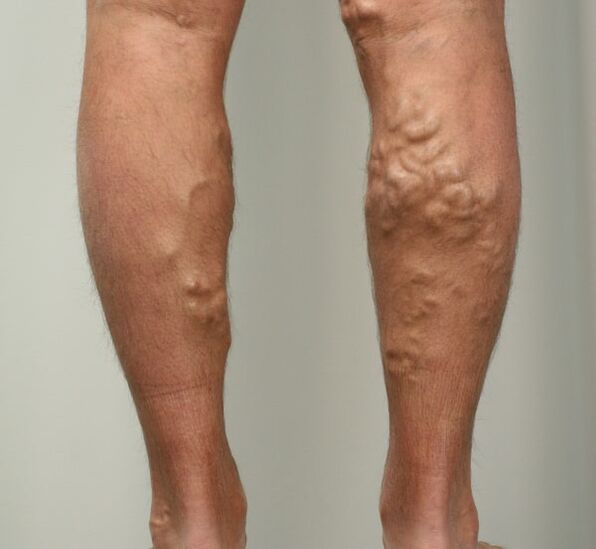
For many people, varicose veins and spider veins are just a cosmetic problem. In other cases, varicose veins cause aching pain and discomfort. Sometimes varicose veins lead to more serious problems and complications - the appearance of thrombophlebitis or trophic ulcers. Treatment consists of removing or closing the deformed veins, which is the job of a phlebologist.
Varicose veins are complete degeneration of the venous wall that results in weakness of the connective tissue (varicose veins in the lower extremities) or a sharp violation of venous outflow due to occlusion or overflow of the veins.
Causes of varicose veins in the lower extremities
The lower extremities are varicose veins
The disease, as a cause of foot varicose veins, occurs in 20-40% of the population in the developed countries of the world. Varicose veins have been an aesthetic defect for a long time, but the progression of the disease leads to pain, swelling of the feet and legs, and in the advanced stage, darkening of the skin of the feet, inflammatory lesions and varicose trophic ulcers.
Hereditary predisposition is the main cause of primary varicose veins, however, the disease develops through excessive use of the veins. The triggers for lower extremity varicose veins are acute physical overload, pregnancy, and childbirth. In this case, there is a sharp increase in pressure in the veins of the lower extremities and damage to the valve equipment, which triggers the mechanism for the development of the disease.
Postthrombophlebitis disease
Secondary varicose veins occur after venous thrombosis or due to congenital diseases (arteriovenous fistulas, congenital venous dysplasia). Post-thrombotic disease is a complex, progressive pathological process in the venous system of the lower extremities. Due to heart valve failure or deep vein occlusion, the saphenous veins dilate as blood overflows. Another cause may be congenital or acquired arteriovenous fistulas. Occasionally, congenital occlusion of the deep veins occurs, leading to secondary varicose veins (Klippel-Trenaunay syndrome).
Complications of varicose veins
More than 40% of women and 20% of men have swollen, dilated varicose veins. In 20% of cases, varicose veins lead to the appearance of trophic ulcers, and more than 25% of patients suffer from varicose vein thrombophlebitis. These complications often require serious treatment and pose a major health risk.
Chronic venous insufficiency
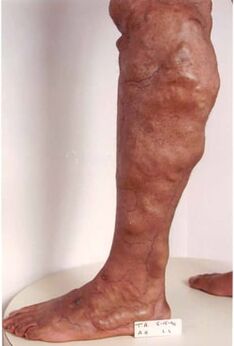
Blocking venous outflow causes a condition called chronic venous insufficiency. At the onset of the disease, the appearance of certain nodules in the dilated veins are observed, which are not of great concern, although they can sometimes hurt. Thereafter, the number of varicose veins increases. The disease develops slowly but steadily. If the first varicose veins appeared below the knee, the rate of disease development was much higher. If the disease is not stopped, the third stage of venous insufficiency gradually develops. The edema perpetuates, dark discoloration of the skin appears in the ankle area, and the weight of the legs is constantly worried, which may persist even after a night’s rest. Varicose veins and dermatitis, eczema and dermatitis often develop. The final stage in the formation of varicose veins is the appearance of trophic ulcers.
Thrombophlebitis of varicose veins
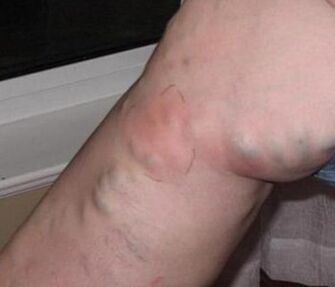
Thrombophlebitis is the most common complication of varicose veins. Thrombophlebitis is an inflammation of the venous wall that results in the formation of blood clots in the lumen of a vein. Thrombophlebitis occurs in superficial and deep veins. In varicose veins, thrombophlebitis occurs in 25% of patients and is usually superficial. Thrombophlebitis in varicose veins is caused by very slow blood flow, especially in large nodes. Under these conditions, any factor that increases blood clotting (pregnancy, overheating, trauma, sprain, hypothermia and scratches, acute respiratory infections) can cause a blood clot to form and become inflamed in the vein. Thrombophlebitis occurs in 25% of patients. with lower limb varicose veins. Thrombophlebitis is caused by a slowed blood flow to the varicose veins. Thrombophlebitis can progress and lead to deep vein thrombosis. Chronic venous insufficiency is a painful condition of venous outflow with varicose veins. It is characterized by edema, darkening of the skin, the appearance of trophic ulcers and varicose dermatitis.
Varicose trophic ulcer
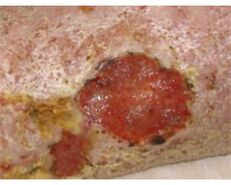
Trophic ulcers are an extreme sign of chronic venous insufficiency. It is a long-term, non-healing wound that occurs with severe violation of venous outflow through deep and superficial veins. It occurs in 1% of the general population and in 20% of venous patients. One in five patients with varicose veins who do not receive treatment will sooner or later get a trophic ulcer. It can develop in both varicose veins and secondary varicose veins. Without the elimination of abnormal venous secretions, varicose trophic ulcers do not heal or recur continuously. Trophic ulcers with varicose veins occur in most patients and cause severe suffering. Modern, minimally invasive methods allow reliable removal of varicose trophic ulcers without incision and pain.
Venous thrombosis and thromboembolism
Pulmonary embolism is a serious complication of venous thrombosis. Varicose veins are important risk factors for thrombophlebitis and deep vein thrombosis. Thromboembolism leads to severe heart and respiratory failure with a mortality rate of more than 50%.
Prevention of varicose veins in the lower extremities
Every modern person needs to understand what varicose veins in the legs are, how to treat them and prevent them from occurring. In case of hereditary predisposition, factors contributing to varicose veins should be avoided. The use of venotonic medications, wearing compression stockings during exercise, periodic examinations by a phlebologist, and ultrasound of the veins appear.
When working under accompanying conditions, the use of compression class 1 compression stockings is mandatory at the workplace, for therapeutic exercises, outdoor activities, at least 1 hour of walking per day in spa stockings, foot massage and swimming. Refusal to use oral contraceptives due to the complicated inheritance of varicose veins. It is better to follow these simple rules than to treat varicose veins in your legs.
Avoid factors during hard physical work. This requires compression stockings, especially if you are prone to varicose veins. Medical knitwear is recommended for all expectant mothers, and if they are prone to varicose veins and thrombophlebitis, they wear special compression stockings for childbirth. During the last weeks of pregnancy, it is advisable for all pregnant women to see a phlebologist and have an ultrasound examination of their veins. This will help reduce the risk of problems with your venous system.
How to treat varicose veins in the legs
Over the past 10 years, "barbaric" methods of treating varicose veins have become a thing of the past, thanks to the emergence of more gentle and effective methods successfully used in clinics.
Varicose veins sclerotherapy

Sclerotherapy is the introduction of a drug into the lumen of the varicose veins that causes the walls to "stick together" as the veins disappear. Many chemicals are used in sclerotherapy, and ozone has been tried. At one time, the advent of foam sclerotherapy revolutionized phlebology. An effective method for treating varicose veins without major surgery first appeared. Foam sclerotherapy is currently used to remove medium-diameter varicose veins after laser removal of abnormal venous secretions. Sclerotherapy is essential for the treatment of cobweb veins and reticular varicose veins where there is no real competitor.
Laser treatment of varicose veins
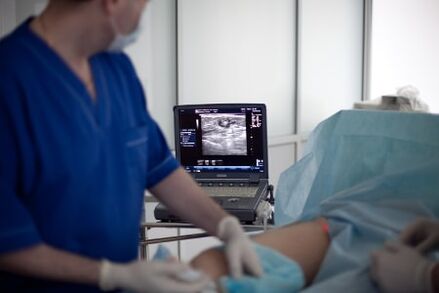
Laser treatment of varicose veins in the lower extremities (EVLT) is the most modern, most radical and cheapest treatment method to treat varicose veins in the legs and eliminate the causes of trophic ulcers. The meaning of laser treatment lies in the thermal heating of the vein wall from the inside and the subsequent absorption of the varicose veins. EVLT’s latest advancement is a 1470nm laser and a radial light guide that have been introduced into medical practice by phlebologists. The postoperative period following this technique is completely painless and the result is better than the other treatment options - the radicality of the laser intervention is at least 98%.
Surgery to remove varicose veins
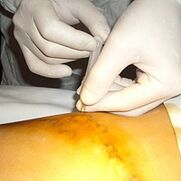
Surgical treatment of varicose veins by removing major venous strains is a thing of the past. The risk of complications for the removal of stem veins has forced phlebologists to look for other approaches, which has led to the development of laser techniques and other methods of thermal removal of veins. However, the conversion of classical phlebectomy to microflebectomy, according to Müller and Varadi, allowed for a wonderful combination of laser treatment and puncture and seamless removal of large varicose veins. Varadi’s technique has saved patients from the painful sclerotherapy for large varicose veins. A miniflebectomy allows you to treat varicose veins and remove visible varicose veins in any part of the body.
Radiofrequency removal of varicose veins
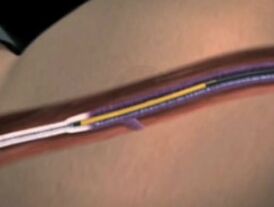
Radio Frequency Obliteration (RFO) of the leg veins is a modern and safe method of treatment. The method is based on a microwave probe that heats a metal probe that is already causing the wall of the vein and destroys the inner membrane. In terms of painlessness, the method corresponds to laser coagulation with a wavelength of 1470 nm, easy to perform, and little postoperative pain. However, in terms of long-term treatment results, RFO is much worse than laser. RFO efficiency is 85% without recurrence. The method is not suitable for the treatment of perforating veins.
Massage and bath for varicose veins
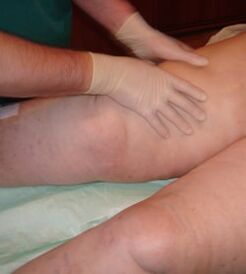
Massage is a method of active treatment of varicose veins.
All types of modern massage are used, especially in the pathology of the lymphatic and venous systems. Exclusive methods include bandage lymphatic massage technology, which is very effective in relieving chronic venous insufficiency.
In chronic venous insufficiency, massage is used to relieve venous hypertension in varicose veins and post-thrombotic syndrome. The combination of this massage with the dressing allows for the effective elimination of all clinical manifestations of the disease.
A bath with varicose veins, thrombophlebitis, or post-thrombotic disease is very dangerous. Any heat load can cause blood clots to form in the deep veins, with all the consequences.
Unfortunately, complete healing of varicose veins is impossible without elimination of venous secretions and varicose veins. Although reduction of the symptoms associated with stagnation of venous blood in the legs is entirely possible with the help of modern therapy. However, the prevalence of varicose veins and chronic venous insufficiency sometimes raises the desire to speculate on this problem. Consider modern handling and fooling methods.
Medications for the treatment of varicose veins
The goal of drug therapy for venous pathology is to reduce symptoms and prevent complications, but these goals are not easy to achieve. Today, the abundance of tools available has posed another problem: which one to choose? Unfortunately, most of the proposed drugs are rather ineffective, despite the theoretically justified appropriateness of their use. There may be a number of reasons for this, the most important of which is that the therapeutic substances in these medicines are low in the body. The ideal drug for the treatment of venous insufficiency should act on as many pathogenetic chains of chronic venous insufficiency as possible, while having a minimal number of side effects and high absorption in the body. A fairly large number of venotonic agents are present in the modern pharmaceutical market. However, they have similar medicinal substances (plant flavonoids), so the effectiveness of one or the other depends only on the concentration and digestibility of the active substance.
These medications are not expected to eliminate varicose veins, however, lightness of the legs, reduction of edema, and cessation of nocturnal cramps may occur.
Creams and gels for treating varicose veins
Despite the high efficiencies advertised by vendors and manufacturers, creams and gels do not bring relief from varicose veins, and varicose veins do not disappear from them. In the early stages of venous insufficiency, phlebologists do not object to the use of these agents, as their rubbing promotes venous outflow as a light massage and has a calming effect on the skin. In advanced forms of venous insufficiency, these creams and ointments can cause dermatitis and allergies and are therefore very harmful. Some medications are used to develop acute thrombophlebitis and help alleviate the inflammatory process, but varicose veins do not go away. Thanks to proper advertising, shaman products made with leeches have become very popular among people, but they are not related to medicines or even leeches, there is no point in expecting them.
Drugs for blood clotting in varicose veins
Varicose veins are a common complication of thrombophlebitis, especially during pregnancy and the postpartum period. A drug used to prevent blood clots is a low molecular weight acid sulfur glycosaminoglycan. Tablets are used in clinics to prevent thrombophlebitis after treatment of varicose veins. It is taken 7 days after laser or radio frequency intervention.
Compression stockings for varicose veins

Compression stockings are undoubtedly one of the most effective tools in treating venous edema and reducing the rate of chronic venous insufficiency. Invented more than 100 years ago, the XX. Compression stockings and stockings, which became hugely popular in the 21st century and even more so in the 21st century, have become an integral part of phlebologist treatment. This is due to the following effects:
- improving venous and lymphatic outflow of the lower extremities,
- improving microcirculation,
- slows the progression of the disease
- prevention of complications of varicose veins (varicothrombophlebitis, trophic disorders),
- prevention of deep vein thrombosis.
How to use compression stockings
So if you have varicose veins and plan to treat them, you will no doubt use compression stockings for a few days or several months (one at a time) during treatment. If your legs swell towards the end of the day after work and you have severe foot syndrome, you can also use compression stockings during the day to avoid these symptoms in the evenings. If you have complications from an untreated varicose vein - trophic ulcer or thrombophlebitis - you will of course also use compression to improve the condition of your legs and reduce any unpleasant symptoms.
The fact is that by improving venous outflow, it improves the return of venous blood from the legs every second of wearing compression stockings, which is undoubtedly not easy for veins at risk for disease and is contrary to the law of universal gravity. Compression knitwear can safely be called one of the ingenious inventions of mankind, but in order to work, several conditions must be met:
- Compression knitwear is selected individually (according to standards). The main requirement is to adhere to the anatomical profile of the limb and thus to establish a proper pressure gradient.
- The knitwear is selected individually by the doctor (phlebologist). Medical products are marked in Hgmm and can be classified in compression classes 1, 2, 3, 4. Each compression class corresponds to a certain pressure. The appropriate compression class is used at different stages of varicose veins or chronic venous insufficiency. That is why only a doctor has the right to prescribe and select the appropriate compression stockings - taking into account the nature of the pathology and according to individual requirements.
- Be medical, not slimming knitwear. Only proven brands with RAL certification.
When do you need knitwear to treat varicose veins?
- correction of "heavy legs" syndrome: reduction of severity, edema, improvement of quality of life;
- during treatment with a phlebologist: after surgery or for a period prescribed by a specialist;
- slowing the progression of varicose veins;
- for the treatment of varicose vein complications (varicothrombophlebitis).
Medical elastic compression is a necessary component of any treatment for varicose veins and chronic venous insufficiency. Thanks to compression therapy, swelling, leg heaviness can be completely eliminated, and conditions can be created for any radical treatment of varicose veins. Modern medical knitwear has a high therapeutic effect and excellent aesthetic properties.
Elastic bandages |
Therapeutic jersey |
|---|---|
The creation of the necessary pressure is determined by the technique and skills of the doctor or patient in dressing |
The treatment profile and pressure level specified during manufacture according to the compression class |
The need for medical participation in dressing or patient education |
Physician involvement is limited to the selection of the compression class and product type |
Difficulty in compression and fixation in the thigh |
Provides effective compression and fixation to the thighs |
Used for non-standard limb shapes |
Customization is possible with a non-standard shape of the limb |
Daily washing causes bandages to wear out quickly |
Daily washing is required to maintain compression properties |
It must be replaced after several washes |
Guaranteed preservation of compression properties for 6 months |
Possible violation of the water and temperature balance of the skin |
The porous dressing ensures normal skin temperature and water balance |
They offer low aesthetic qualities, comfort and convenience |
High aesthetic properties, comfort and convenience during use |
Exercises and sports come back
Strength sports for varicose veins and athletics are possible after the cessation of varicose syndrome or in compression stockings with 2-3 compression classes. Modern treatment is able to restore varicose legs to a normal state, which removes all restrictions.
We recommend a complex of therapeutic and preventive practices developed by leading experts. Regular use helps reduce the incidence of venous insufficiency in the lower extremities, slows the progression of the disease and reduces the risk of life-threatening complications.
- Relief of leg veins. Breathe deeply and evenly, lie down with your eyes closed, relax. However, place a few pillows under your feet so that they rise at an angle of 15-20 °.
- Cycling practice. Lying on your back and breathing evenly, imagine you are pedaling a bike.
- The exercise consists of several parts, carried out slowly and smoothly. Lying on your back, with your legs outstretched, take a deep breath. When exhaling, bend your right leg by pulling your knee to your chest. When inhaling, straighten your legs upright. Exhale, let go. Repeat this exercise alternately on each leg.
- Lie on your back with your arms along your body, lift your legs vertically. Rotate both feet inward and outward at the same time.
- Alternately bend and bend the foot forward and backward at the ankle joint.
- Alternately bend and bend your toes.
- Stand in position: legs together, arms along torso. After taking a deep breath, slowly rise to your toes and exhale to return to your starting position.
- Walk in place without lifting your socks off the floor.
- Vertical scissors. Lie on your back, arms across your body, breathing evenly, alternately cross your legs, alternating them.
- Lie on your back, bend your knees without lifting your legs off the floor. Put your hand on your hip. Inhale slowly, lift your head and torso. At the same time, the hands slide to the knees. Exhale slowly to the starting position.
- Lying on your back, with your arms along your body at an angle of 15-20 ° to your legs, hold a small pillow between your legs. Inhale slowly, bend your waist, tear your buttocks off the mattress. Exhale slowly to the starting position.
- Lying on your back, arms along your body, bend your knees, keep your feet on the floor. Exhale slowly, tighten your stomach. Inhale slowly to inflate the stomach.
- Lying back, legs raised at an angle of 15-20 °. Bend your right leg by pulling your knee to your chest. At the same time, squeeze your feet tightly with your hands. Slowly straighten your legs. Slide your hands tightly together along the calf to knee level. Slowly lower your legs, sliding your hands over your thighs. The exercise is repeated on the other leg as well.
- Standing, legs together, arms along the body, inhaling slowly, shoulder back, exhaling slowly, relax your shoulders and tilt your head forward.
- Contrast shower on the feet. Variable hard jets of hot and cold water. 5-10 minutes for each foot.












































